
Batman: Mask of the Phantasm Review
- The World's Most Iconic Batman, World's Most Ignored Batman Movie
All legends come blessed with a hero—mortals or gods forced into overcoming incredible odds. Samson. Hercules. Beowulf. Odysseus. King Arthur. Their tales have become so retold, so ingrained in the sands of time, the heroes themselves have become frozen by their own legacy—trapped by the archetypes they helped define. Such timeless titans resist simple redefinition, transcending the Hollywood machine for a spot in the human unconscious. Heroes like Odysseus and King Arthur have become as immutable as The Ten Commandments, etched in a kind of imperishable, allegorical stone. They stand as a reference. An instinct. A guideline…inscribed in the tableau of the human mind.
But modern myth is different. Associated largely with the superhero, this new breed of demigod resembles those old, legendary champions…but is less static. More plastic. And thus, much more vulnerable to being re-chiseled into a million new images. From Batman to Astro Boy to even King Kong, the modern hero is one of flux…of fluid repurpose. While Beowulf’s tale stood unchanged for millennia, a character like Batman shifts with the whims of his writers and the demands of an ever-fickle market. His origin, personality, abilities, setting…are, at best, like wet cement…able to be reshaped by anyone given the needed permission. He’s an Agent of Justice. An Angel of Vengeance. Redeemer. Tyrant. Reluctant hero. Obsessed vigilante. All-American playboy. An optimist. A brooder. A team player or an abject loner. A man trapped by his past. A man conquering his own ghosts and limitations. Batman has been squeezed into every story imaginable in the span of a century. He’s the Hero of a Thousand Faces all condensed into one. The monomyth times a thousand.
The debate rages whether these competing versions of Batman dilute the archetype he represents. Indeed, years of comic books, cartoons, movies, and video games have remixed and reinterpreted and deconstructed the character almost to the point of triteness. No definitive Batman exists—just his distillation—an “average” taken from his many iterations. From a cheerful do-gooder to scowling maniac, everyone has a favorite Caped Crusader.
But what if all these Batmen could be blended into a singular character—a composite of all the grimaces and a melding of all the cowls depicted across the decades? What would that man, that hero—that mythological figure and overarching construct—look like?
This Batman, of course. The Batman of the 1992 animated series.
…
Circa 1992, Batman was enjoying a resurgence in mainstream popularity. Tim Burton’s Batman and Batman Returns films had made the hero relevant again, pulling The Dark Knight away from the camp and back to the black. This Batman, in stark contrast to his goofy ‘60s incarnation, was a brooding man still haunted by the murder of his parents. Similarly, his villains were more sinister than silly, often deranged and certainly dangerous. Even Gotham City reclaimed its namesake by becoming gothic again, with the days plunged in a perpetual dusk, and the nights recast in a moody gloom.
To capitalize on Batman’s comeback, animators/producers Bruce Timm and Eric Radomski conceived of an animated version—a weekday cartoon that would emulate the movies’ angst and pathos while still remaining appropriate for the school-age market. The grimy skylines and grim city streets were still there, but streamlined with the stately Fleischer Studios-esque style that had so distinguished the 1940s Superman shorts. Some characters, like Catwoman and The Penguin, were influenced by their Tim Burton imaginings, while The Joker, Mr. Freeze, Two-Face, and others bore a more unique (or classical) depiction.
But most important, of course, was the singular Batman himself, a man torn between his two personas—the playboy Bruce Wayne, his public self, and The Batman, that avenging watchman always stalking the streets of Gotham. Voiced by the esteemed (and late) Kevin Conroy, the character felt real in either purview, his voice sliding higher when invoking the pretty boy, and grinding low for the shadowy hero. And though this duality wouldn’t always be emphasized during the show’s initial 85-episode run (1992-1995), it plays a significant role in the adjoining film: Batman: Mask of the Phantasm.
Originally intended as a direct-to-video home release, the film was shuffled last-minute to theaters and serves as a sort of addendum linking the TV series’ first and second seasons. Due to its rushed nature and poor marketing, the movie went largely unappreciated until it found viewers through the home video market. Years later, it’s considered an off-beat classic—the dark horse of Batman filmography that everyone ignored, but later, came to respect...if not outright adore.
…
Mask of Phantasm is essentially an origin story. But unlike most superhero films, from Spider-Man to Doctor Strange, this isn’t the characters’ first introduction. The TV series had already defined its heroes and villains through season one’s 65-episode run. It’s a fact that lends the feature film an almost nostalgic quality…like a concurrent, ongoing flashback stretched into a fever dream that may or may not represent true reality.
Indeed, the movie is a series of scenes weaving between past and present—Andrea Beaumont, Bruce Wayne’s former ladylove, has returned to Gotham…and this discovery sends the disheveled Caped Crusader reeling through a series of wistful, then painful, reminisces. How the two met. How they fell in love. How he was forced to choose between marriage and serving Gotham as the ever-vigilant vigilante. And how, after happily accepting Bruce’s proposal, she abruptly vanishes overseas with her father…never to be seen again.
Until now.
If Phantasm’s odd retcon of events are to be believed, Bruce Wayne very nearly abandoned The Bat. Only Andrea’s sudden snubbing redirects the socialite back to the original plan—that fateful promise he made to his parents’ grave. He will avenge them. He will protect the innocent. He’ll fight and sacrifice to make Gotham nice.
It’s a plot that, in light of the animated series, feels a little forced—no TV episode even hints at the broken heart and ensuing drama so indicated here. But for those less concerned with the source material—the casual fans and less uptight types—the movie does offer a compelling glimpse into the hero’s early life rarely explored in other mediums. It also raises some interesting questions: What if Bruce hadn’t become Batman? Would he have been happier overall? Would his broken promise been forgiven? Or would Fate still have intervened, intent to have its Bat no matter the circumstance?
But Andrea is only half the story: a mysterious killer known as “The Phantasm” is singling out a ring of old-time gangsters, icing them one by one. Batman soon becomes framed for the murders, a predicament that sees the entire Gotham police force hunting him down. Meanwhile, one of these gangsters, fearing he’s next on the killer’s hit list, seeks out the Joker for help. Apparently, Batman’s most heinous (i.e. most popular) foe was also a member of the same outfit now being so methodically eliminated. Ultimately, it’s an epic three-way melee between the three personalities—the Bat, the Phantom, and the Madman fighting for justice, vengeance, and mayhem. (Respectively or collectively?)
In terms of the overall Batman mythos, Mask of Phantasm entertains…but it was never going to become the de facto origin of Batman’s formation. The quintessential Batman that everyone imagines in their heads might come from the animated series, but the movie fails to establish the same with his origin. Phantasm’s tale is too convenient, and a little too contrived, to be anything more than an interesting what-if or Elseworlds-style tale. It’s not helped by the animation which, though excellent by TV standards, is barely passable for a theatrical release. Had it been cut into four normal episodes and shown on television, few would have perceived a difference in quality.
The 4K Ultra HD release is also a smidge disappointing, alternating peculiarly between scenes of exquisite sharpness and those of a much softer image. It’s not hugely distracting, but standing as the film’s “definitive” version, it seems a sloppy oversight. Extras on the disc are also thin, offering nothing beyond a fond tribute to Kevin Conroy. Why not include, at the very least, a few select episodes of the animated series, or the famous Justice League Unlimited episode in which “The Phantasm” makes a surprise reappearance?
Incidentally, the film earns points for its sly details and wry observations. Seeing Batman attack in his dark, angelic best, then watching him bumble as the playboy Bruce Wayne, makes for a fascinating contrast. Moreover, Batman’s attempt to “redeem” the Phantasm is a smart rethreading of his own life journey, one in which he could have easily lost his soul and become the very scum he battles. Batman managed to escape that fate, but the Phantasm’s path proves more tragic.
Batman: Mask of the Phantasm is a good film undermined, slightly, by its television roots—too low-budget, and too predefined, to be anything more than a clever addendum. An appendix to this Batman’s specific continuity. But for those weary of the post-Christopher Nolan Batman films, or those seeking anything resembling the great, stylized timelessness that was Batman: The Animated Series, this movie is sweet comfort food. A vestige belonging to a bygone era that, just like the Fedora and the Tommy Gun, faded with the grains of Fate. It’s not an excellent film, but it is an excellent reminder of the one Batman that stands above all others. Iconic and unironic.
The figure everyone sees when “Batman” is invoked. The shadow they see in their darkest dreams.--D
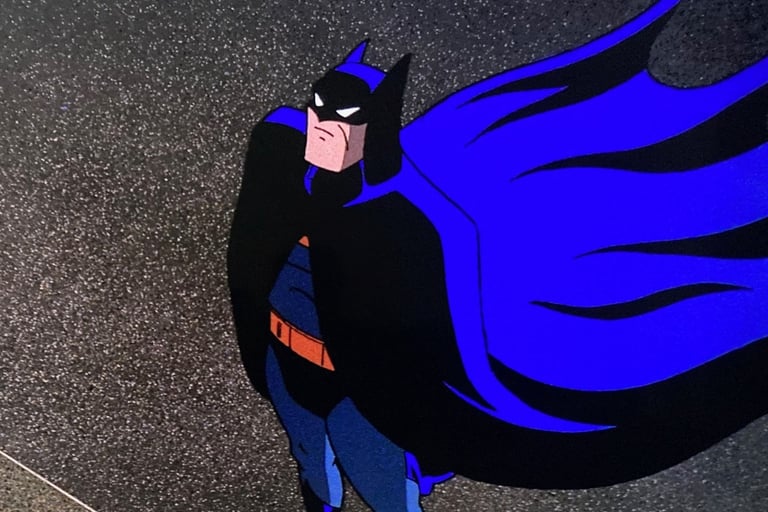

Batman stands ever vigilant, an avenging angel, an agent of justice. Everyone wishes their city had a Batman (or a Superman as the case may be).
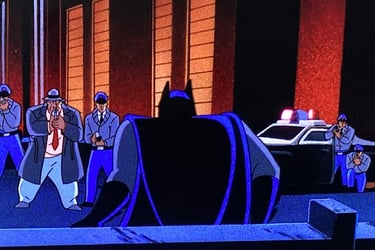

Phantasm's Batman is not friendly with the police; indeed, he's almost felled by them later in the film. The never-seen FBI, however, are apparently blind to the Bat's antics.
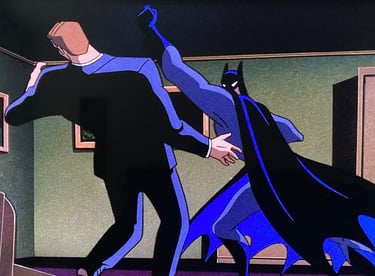

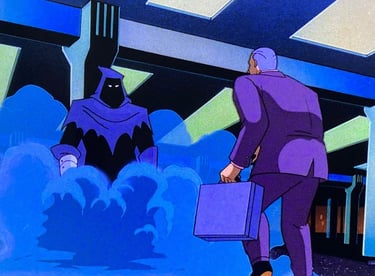

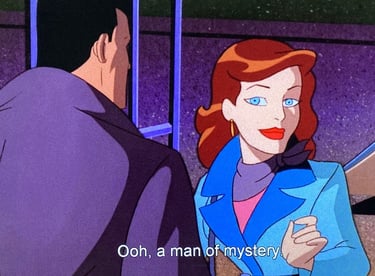

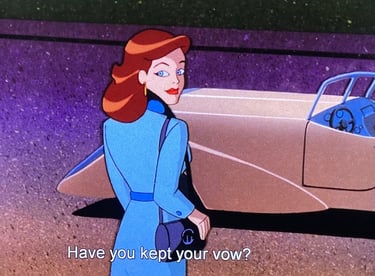

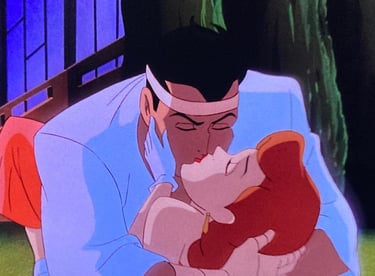

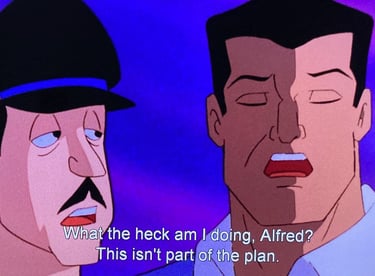



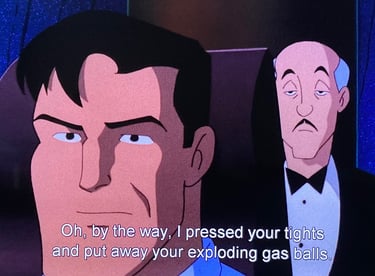

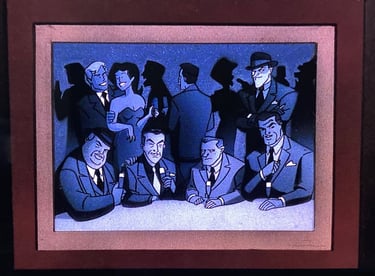

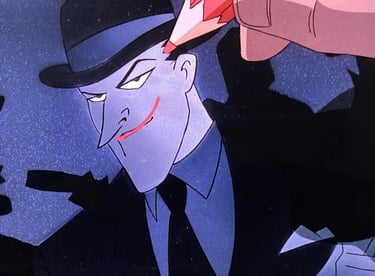

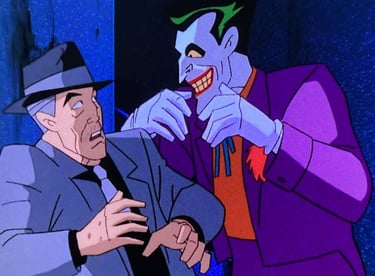

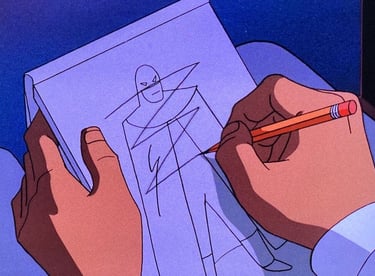

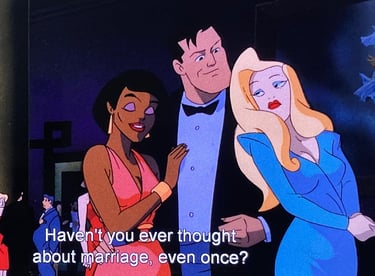

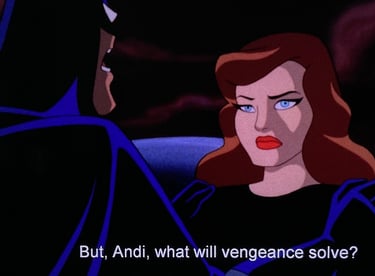

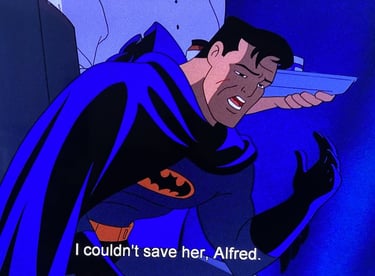


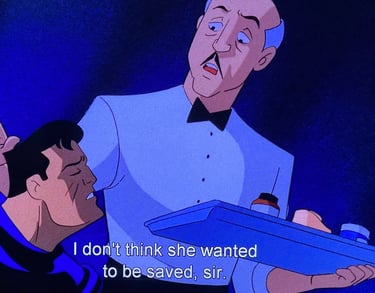
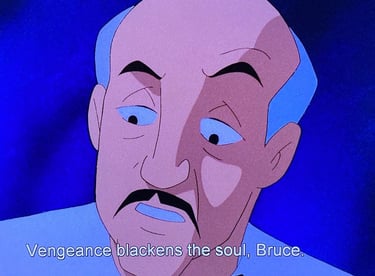

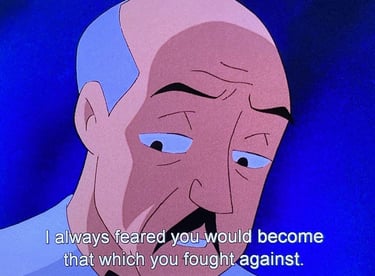

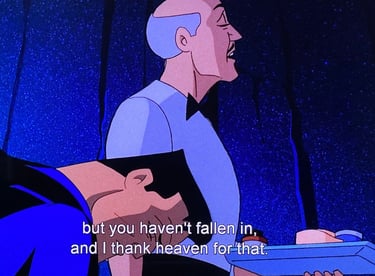

The animation and art are generally good, but freeze-framing the action reveals plenty of oddities. Batman sure has a lengthy left hook!
The Phantasm as first revealed...not a Grim Reaper so much as a Reaper of Revenge. The being is like a twisted version of Batman, obsessed more with vengeance than true justice.
The movie is not without some self-aware humor, as seen in this droll moment with Alfred.
Batman's Bruce Wayne alter ego gets some not-so-flattering screen time. The girls yearn; the playboy spurns.
Bruce scratches out a sketch of what will become his iconic Batsuit. He forgot the ears.
Andrea Beaumont is the picture's femme fatale-- the reason Bruce almost gives up the cowl, and later, why Bruce doubles back down on his vow. If keeping his promise means gallivanting as a bat...are his parents happy or sad that he kept his word?
Yep, the movie couldn't resist including the Joker who's also given an updated origin of sorts...
In the film's closing scenes, Alfred counsels a distraught Bruce on the precarious nature of vengeance. Batman has avoided becoming the monsters he fights, but not every "hero" is so pure or fortunate.
Contact: lostnostalgiaproductions@gmail.com
Website: www.lostnostalgia.com
Like what we're doing? Please consider throwing us a dollar into our Patreon page's tip jar!


